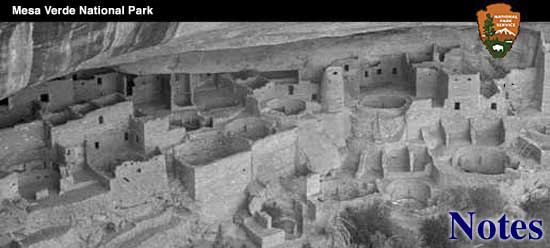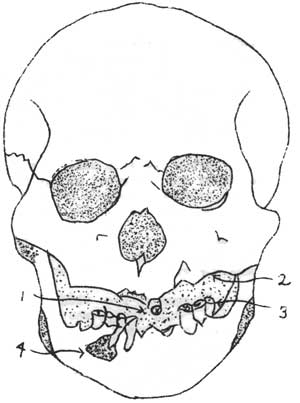

|

The cliff dwellers have at last been to the dentist. The results are certainly enough to convince anyone that a visit to the dentist should not be deferred 800 years. Almost every common dental ailment was found to have been suffered by the former inhabitants of the Mesa Verde, and some cases proved so tragic that one can only wonder how the fable of the American Indian with perfect teeth ever originated. James Fenimore Cooper probably started it and all writers of Indian stories since his time have continued the idea until the average American is pretty well convinced that Indians enjoy perfect dentition. Scientists have long since found that this is far from the truth and the examination of the teeth of the cliff dwellers adds more evidence to the case. This dental examination came as a result of an effort that is being made in the park museum to present visible evidence of the diseases from which the cliff dwellers suffered. The idea that Indians enjoy perfect health is so firmly embedded in the minds of the visitors that a verbal denial does not suffice; visual evidence is needed. As a result an exhibit has been made of bones that show evidences of disease. It is immediately evident, of course, that only those diseases that affect the bones can be detected. The moment the work began it became evident that the help of specialists was needed, for many of the bones showed evidences of complicated diseases that would bear long names. Local doctors were first consulted and at their suggestion a number of the bones that showed puzzling abnormalities were sent to specialists who have used all possible tests in determining the causes. Through these studies considerable knowledge has been obtained of some of the diseases from which the cliff dwellers suffered. The dental examination was conducted by a well-known dentist in one of the nearby towns. The results showed that the early inhabitants of the Mesa Verde suffered from most of our common dental troubles. Caries, attrition, abscesses, pyorrhea, loss of teeth, impactions, alveolar resorption, and abnormal alveolar growths were all plainly evident. The series studied represented thirty-four individuals. Complete evidence was not available in every case, for only eighteen were represented by both upper and lower jaws. Twelve were represented by the upper jaw only and four by the lower jaw only. For this reason percentages derived from the group are not as positive as they would be if each individual were represented by both upper and lower jaws. The results, however, give a good picture of the dental ailments of this group of thirty-four individuals. All of these were adults, as children's teeth were eliminated from the study. The frequencies of the various ailments were as follows:
These percentages agree very closely to those Dr. H. Y. Rihan obtained on a group of 289 skulls from the Pueblo of Pecos in eastern New Mexico.#
Thus it would seem that the percentage of Indians that walked the floor at night because of aching teeth was about the same in both places. The high percentage of attrition (wearing away of the grinding surfaces) was not unexpected. All of the individuals were adults, and when their food is taken into consideration it is easy to understand why each one suffered from attrition. The principle food was corn of a flint variety. In addition they utilized nuts and berries and certain roots and fruits of fibrous types. All of these would have been hard on the grinding surfaces of the teeth. Another factor was the use of the soft sandstone manos and metates for grinding their corn. Much sand must have ground off into the meal and the tiny quartz grains were particularly destructive to tooth enamel. In the skulls of some of the older individuals the teeth were ground down almost to the bony processes. After the pulp was exposed the teeth were especially susceptible to decay and the great amount of attrition, plus the lack of a varied diet, probably accounts for the prevalence of decayed teeth. After decay had once set in the individual could only sit by and wait for the inevitable ache. No evidence has been found that the cliff dwellers did anything to alleviate the pain of their aching teeth, but surely the medicine men had secret potions and mysterious incantations that were supposed to dispel the demon that caused the trouble. In some of the older individuals the condition of the teeth was tragic. Only those who have gone through the worst possible dental troubles can appreciate the sufferings of some of the individuals listed below. With no knowledge of efficacious treatment for decayed and abscessed teeth it is difficult to understand how these unfortunate victims endured the months and years during which their decayed teeth abscessed and finally sloughed away, bringing at last the relief of painless toothlessness. No. 2632. Lower jaw of old man. Advanced, pyorrhea. Alveolar abscess of right first molar. Left second and third molars decayed. These two teeth on the left side were aching so the man chewed on the right side. As a result the right molars were ground down almost to the gums. No. 1081. Skull and lower jaw of very old man. Had lost twenty-six teeth before death. Upper alveolar processes (bones containing the sockets of the teeth) completely resorbed. A blow had chipped away a piece of the upper jaw bone. No. 2851. Skull and lower jaw of young woman. Mal-position of upper left, first bicuspid. Upper left wisdom tooth impacted. It was growing directly away from the other teeth. Both lower wisdom teeth impacted. Five molars decayed. No, 673. Skull of very old man. Had lost four teeth before death. Eight teeth were decayed, six of which were merely hollow snags. Extreme attrition. This man had evidently suffered from hypertrophic arthritis as all of his vertebrae had fused solidly together. No. 1084. Skull of an old man. Had lost six teeth before death. Left, first molar decayed. Abscessed, left, lateral incisor and first bicuspid had developed into a cyst that drained into the man's mouth. Right, first bicuspid also abscessed. 
No. 641. Skull of an extremely old man. Had lost all teeth. Great age or disease had worn the alveolar process completely away until it was even with the roof of his mouth. No. 2866. Skull and lower jaw of very old man. Had lost twenty-one teeth. Only one tooth, an incisor, left in upper jaw. Had chewed on gums until whole front of the alveolar process was pushed forward, the single tooth pointing directly forward. 1. Portions of the alveolar process were completely resorbed. 2. The pulp of all teeth was exposed. 3. An abscess of the lower, right canine tooth had developed into a cyst that drained out through a running sore on the man's chin. 4.
After many years spent in the security of a glass case in our museum, Tony the Dwarf, has left us. Tony is no more; the cold eye of the X-ray has taken her away. A number of years ago this small mummy, that was christened Tony at the time of discovery, was found in a crevice at the rear of Mummy House. At first it was considered to be the mummy of a small child. Only the upper part of the body was preserved, but it was plainly evident that in life the individual had been about the size of a five year old child. After a bit of cleaning up, Tony was put on display. Soon a controversy arose. Because of certain evidences on the body some doctors thought that it was the mummy of an adult woman rather than that of a child. Without hesitation some called it a Creton, or dwarf. Other doctors did not agree: some thought it to be the mummy of a child, while others hesitated to give an opinion without more than a cursory examination. A satisfactory diagnosis was difficult to make because of the shrivelled and dessicated condition of the body, and although the name, Tony the Dwarf, stayed with the small mummy, the matter of its age was not settled until this winter. When the rest of the cliff dwellers went to the dentist Tony went along. An X-ray picture was taken of her lower jaw, and as the film emerged from the developing solution, Tony the Dwarf, disappeared. Into her place stepped a five year old child, for the picture showed an unerupted, six year molar in its proper place in the jaw bone. | ||||||||||||||||||||||||||||||||||||||||||||||||||||||||||||||||||||||||||||||||||||||||||||
| <<< Previous | > Cover < | Next >>> |
vol7-1d.htm
14-Oct-2011